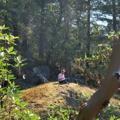peter reviewed What we see when we read by Peter Mendelsund
Intriguing visual essay on phenomenology of reading
No rating
This visual essay is based on a premise that doesn't really hold true for me, in that I have never really felt that I "see" when I read. So when Mendelsund tries to convince me that "seeing" is a false impression that's disconnected from the actual experience, I'm already there. If there's a revelation to be had from that, it's just that I thought other people with a stronger visual sense would have a different experience. Maybe not.
Outside of that, I definitely enjoyed Mendelsund's flair for visual metaphor, and the book's questioning of the experience of reading. It's kind of amazing how much The Master and HIs Emissary is impacting everything else I read that comments on perception and phenomenology and philosophy of mind. Here, Mendelsund describes what we "see" of the characters and settings we read about as fragmented, detailed in parts but not additive—more details don't create …
This visual essay is based on a premise that doesn't really hold true for me, in that I have never really felt that I "see" when I read. So when Mendelsund tries to convince me that "seeing" is a false impression that's disconnected from the actual experience, I'm already there. If there's a revelation to be had from that, it's just that I thought other people with a stronger visual sense would have a different experience. Maybe not.
Outside of that, I definitely enjoyed Mendelsund's flair for visual metaphor, and the book's questioning of the experience of reading. It's kind of amazing how much The Master and HIs Emissary is impacting everything else I read that comments on perception and phenomenology and philosophy of mind. Here, Mendelsund describes what we "see" of the characters and settings we read about as fragmented, detailed in parts but not additive—more details don't create a more vivid image, even if they do create a more rounded understanding.
I kept thinking of the left-brained mode of perceiving, the one that dissects and strips of context, that knows the parts that make up a whole but can't seem to understand how to put them together. Mendelsund isn't using that framework, but everything he says fits the idea that literature and language more generally is the domain of the dissecting left brain.

